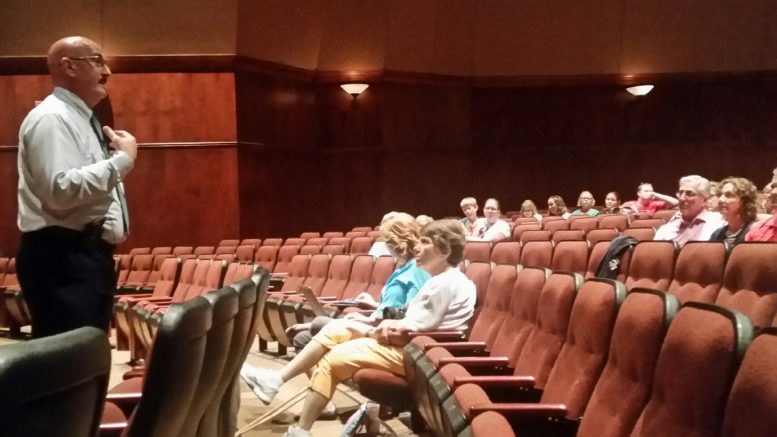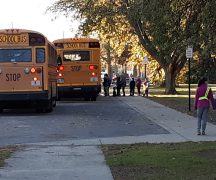By JAN LARSON McLAUGHLIN
BG Independent News
The school bond issue faced a little more hostility from residents during the second public forum on the issue Thursday evening. But it also was met with some heartfelt support.
Bowling Green City Superintendent Francis Scruci started the forum with an overview on the bond issue for new and renovated school buildings. The evening was heavy on numbers – and some were pretty hefty. In order to raise nearly $72 million for the buildings, the district will need to pass a 6-mill bond issue that will go on for 37 years.
“It is a big number, there’s no way around saying it,” Scruci said.
For the owner of a house valued at $100,000, that means an extra $210 a year. But since the average house value in Bowling Green is $170,000, Scruci said that would add up to $357 a year. And for those on the higher end, with a $250,000 home, the bond issue would mean another $525 a year.
Some citizens in the audience said they aren’t against students, teacher or schools – but they just can’t afford the project.
“Have you seen the crops under water,” shouted Chris Sabo.
Scruci said he realized the cost was high – but so is the reward, he said. “This is an investment in our kids. This is an investment in our community. This is an investment in our future.”
But to Sabo, the cost is too high.
“Then you’re not going to have a city, cause everybody is going to move out,” he said. “This is a big chunk of money and it will be with us for nearly 40 years.”
However, another voice in the crowd said her family just moved to Bowling Green. Tracy Hovest said her children are too old to benefit from the consolidated elementary plan, but she realizes the importance of investing in students.
“The only question I have is – how can I help?”
Realtor Sandy Rowland also defended the bond issue request, and disputed that higher school taxes will drive people away. The most robust housing sales in the region, she said, are in the Perrysburg, Anthony Wayne and Northwood school district – all which have much higher school taxes than Bowling Green.
The building plans call for partial new construction and renovation of the high school, plus construction of a consolidated elementary school north of the existing middle school and high school complex.
If the bond issue passes in November, the elementary would be built in about three years, and the high school project could be done in three and a half years. No “swing space” would be needed, since students would stay in their existing facilities until the new buildings are constructed.
Scruci maintained that the school district should not continue to put good money into 67-year-old buildings that don’t have “good bones.” The board is not interested in taking state funding for construction, since the state would contribute very little because its formulas have pegged Bowling Green as an affluent area.
Several other school districts in Wood County have used partial state funding of new construction. However, they all received much larger percentages of the cost since they are not considered to be as wealthy as Bowling Green appears on the state formula. Otsego, for example, got at least half of its new facilities paid for by the state. But the 11 to 13 percent promised to Bowling Green would not make it worthwhile, Scruci said.
“When you take state money, you have just turned the keys over to the state,” he said. “You lose all local control.”
In response to concerns voiced at the last forum about traffic congestion at the centralized elementary, Scruci mentioned a possible solution. School officials have talked with city officials about a possible land swap that would give the district acreage stretching from the west end of the school property to Van Camp Road. That could give the elementary a possible entrance from Van Camp and an exit onto Fairview. Discussions will continue to see if the district could possible trade the Conneaut Elementary property for the access to Van Camp Road, Scruci said.
The centralized elementary school will allow for more teacher collaboration, equity of resources, even class sizes, and elimination of labels, the superintendent said. It will also be able to accommodate children with disabilities who now have to go elsewhere.
It has not yet been determined which model of a “school within a school” will be used at the elementary. It may involve having K-1, 2-3, and 4-5 “houses,” or two K-5 “houses.”
A retired teacher in the crowd questioned the consolidated elementary. “Convince me that bigger is better,” she said to Scruci.
Scruci replied that while the elementaries will be centralized, within the building the children will be parts of communities. The consolidation will allow for a cohesive path from kindergarten to 12th grade.
“Our number 1 job is to educate kids,” he said.
Tom Klein complimented the district for overcoming the disadvantage of the “independent contractor teacher.” Team teaching will allow for collaboration, idea and resource sharing.
Delaying the construction is a poor decision on many levels, Scruci said.
“To kick it down the road will just increase the costs,” he said.
Plus, the elementaries are already at capacity – with Conneaut using a modular unit for some classes. All of the elementaries are using non-classroom space as classrooms, Scruci said. In one school, a music teacher conducts classes in a space previously used as a shower-locker room area.
“Modulars will be in our future if we don’t get something passed,” Scruci said.
Putting off construction will also result in the district losing more potential students to other school districts, he said. “If we’re going to attract families, we can’t allow our schools to disintegrate.”
Plans call for Conneaut and Kenwood elementaries to be demolished, with that expense already included in the costs. Crim Elementary would be used as a central administration building, which would mean the district would no longer have to rent space for that purpose.
The high school plans call for construction of a new academic wing, kitchen/cafeteria and gymnasium. A new gym will be able to seat 2,000, compared to the current 1,200. That will allow for the district to bring in revenue by hosting athletic events. It will also allow the district to hold graduation at the school rather than pay to use BGSU’s Stroh Center, which costs as much as $7,000 for rental.
The high school project will take place in four phases, so as to disrupt students as little as possible. The first phase is construction of the new academic area. Scruci said he hopes to approach local businesses about adopting rooms, such as a company helping to pay for the science room – to take some of the pressure off taxpaying residents.
The second phase is the demolition of the existing academic areas. The third is construction of the kitchen/cafeteria and gym. And the fourth is renovation of remaining classrooms.
Scruci said by renovating a portion of the high school rather than building all new, the district was saving about one-third of the cost.
“This is a fiscally responsible decision,” he said.
The new buildings will be air conditioned. “That’s an important piece, but it’s not the driving factor of why we need this,” Scruci said.
The district wants residents to submit questions about the projects and bond issue at BGOHCitizens@gmail.com. Facts about the plans can be accessed at @BGOHCitizens on Facebook, Twitter and Instagram.





